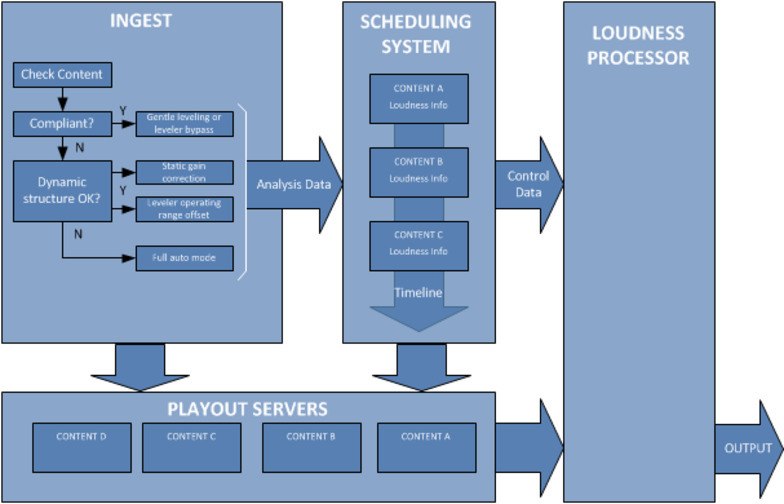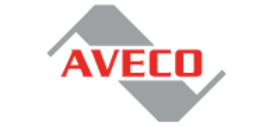Integrated Loudness Management
Wouldn’t it be fantastic to integrate the control of loudness processors into an automated workflow? We believe that a broadcast automation (scheduling) system is the perfect base for all information a loudness processor needs to operate seamlessly within a playout environment. This article describes a workflow with different levels of integration and is intended to give you some ideas for your systems design.
A loudness based leveler is basically an automated console master fader driven by a so called “sliding analysis window” to gather loudness data of the current incoming program. This analysis window “slides” over the program and permanently compares the input loudness with the desired target loudness and generates the control signal for the master control stage. Finally this control information is used to control the master level stage to keep the output “on target” while permanently adopting time based parameters like attack or release to the content (adaptive processing) . This is the automated version of an audio engineer using a loudness meter and permanently keeping the program loudness in the desired target range manually. With this automated process, the engineer may concentrate on the creative part rather than spending man power on a process that can easily be automated.
How to optimize a leveler?
Levelers take automatic care of your output levels by comparing the input to a preset target level. Ideally a leveler should operate without audible artifacts. Within a consistent program this is easily achievable by selecting a quality leveler that optimizes settings according to the audio genre. This is not really ‘rocket science’ a set of e.g. 3 leveler presets will do the job:
- Live
- Movie
- Advertising
So basically inner-content leveling is easy to optimize.
The real world however…
It becomes a little more difficult discussing inter-content areas. This is the transition between program A and program B. For better understanding here is an extreme example: Program A is archive material and leveled to “old” standards w Program B is a short teaser already leveled to “new” standards
As program A is too loud, the leveler will decrease the level to reach target level. We at Jünger spend significant effort to make this “get the program to target” process by maximum control but inaudible as possible. The leveler is in attenuation mode when Program B becomes active [program change]. This will ultimately result in program B to start too soft and the level will increase as the analysis window slides into program B. This causes disturbing audible fading effects. The solution for this effect is to enable the leveler to “know” what the next content might be like. This sounds complicated if not impossible but is easier than you might expect:
The real world solution
Let’s look at a bigger picture now. Of course a leveler in an isolated view will never have a chance to generate control information for future content, but we at Jünger enabled the leveler to gather future content information just in time:
New Content Trigger
The Broadcast Scheduling System might send a trigger identifying a new content. This trigger might be presented as network trigger or as simple as GPI. No matter what the physical trigger mechanism might be, all Jünger solutions provide the possibility to access individual parameters by individual physical triggers.
Pictures: Transistion between Program A/B with and without Integrated Leveling
Broadcast Scheduling Systems (a workflow description)

In this workflow description the broadcast scheduling system (BSS) becomes the central controller not only to trigger the content playout but also to control a loudness solution downstream. This requires the BSS to hold content related information (metadata) to identify loudness related parameters for the loudness processor. Please keep in mind that the central role of a BSS in a playout environment is to control playout servers according to a playout schedule or timeline. Why should the loudness related content information not be generated during ingest?
Content Compliant
During ingest the content will be QC checked and identified as loudness complaint (content already produced compliant with the current loudness regulations). A flag in the BSS might identify this content as “COMPLIANT” triggering the leveler to bypass or to operate in a very gentle setting.
Content Not Compliant [Static Gain Correction]
While ingesting non-compliant material like archive material an automated measuring stage will generate a gain offset bias to get the content compliant by static gain offset during playout. This gain offset might be transferred to the loudness controller (for each individual program) to get the leveler prepared right before the content comes to transmission.
Content Not Compliant [Leveler Operating Offset]
This is an alternative to the static gain offset example: while ingesting non-compliant material, e.g. archive material an automated measuring stage will generate a gain offset bias to get the content compliant by changing the leveler’s operating range.
Live Content [Full Automatic Mode]
For live content it might be advisable to get the leveler to operate quick and fast as the input signal might come from abroad or is not correctly leveled at all or some such. You see, it is more than beneficial to integrate the loudness control system into your playout environment as the BSS is then controlling details of your processor content by content in a fully automated manner.
How to get EXTERNAL CONTROL of Jünger devices?
Basically it doesn’t really matter which physical interface you choose for external control. All our products support both of the interfaces below:
External control via GPI/O
A very simple and straight forward way for external control is the use of GPI/O’s. This makes integration quite easy and lowers the programming and configuration effort needed for set up. On the other hand only a limited set of triggers are available.
Open Control Protocol
With the idea in mind to enable external control systems to access each and every parameter of Jünger equipment, we decided to use an open protocol standard based on the Ember protocol set. This protocol is becoming an industry standard for accessing individual parameters across different manufacturer’s equipment to unify the operational aspects across a broadcast facility. Ember+ is an initiative out of the Lawo Group .
Just download this document as pdf or discover more related articles in our WHITEPAPER-section.





